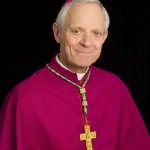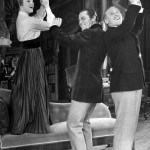On Tuesday, the New York Times reported that the Atlanta-baed law firm King & Spalding renounced its commission to defend the Defense of Marriage Act on Congress’ behalf. According to the Times, this isn’t unusual. For opponents of same-sex marriage, it’s hard to find good help these days:
The firm’s abrupt reversal highlights the continuing potency of same-sex marriage as a complicated issue that has scrambled traditional political calculations in Washington. President Obama has often called the marriage act “abhorrent,” but his Justice Department defended it for more than a year before declaring it unconstitutional. Attorney General Eric H. Holder Jr. announced in February that the administration would no longer defend the act in court.
Theodore B. Olson, a solicitor general under President George W. Bush, has joined gay rights groups and Democrats as a leading advocate for same-sex marriage. And several high-profile Republicans, including Mr. Bush’s wife and his daughter Barbara, have said publicly that they support gay people’s right to marry. But House Republicans, led by Speaker John A. Boehner, have vowed to defend the law in court.
The Times makes it clear that the firm withdrew “amid pressure from gay rights groups,” but what strikes me is the form that pressure took. Gay rights groups warned that staying on the case “would hurt its ability to recruit and retain lawyers.” In an op-ed piece published today, Dale Carpenter argues that the firm’s decision “cannot be dismissed simply as a matter of political correctness or bullying by gays.” Gay rights supporters have come to dominate the legal profession.
Any doubt left about where most lawyers stood was eliminated in 2003 in Lawrence v. Texas, which involved another sodomy law. Lambda Legal led the challenge, helped by Jenner & Block, a firm with extensive Supreme Court experience. Other big firms, groups like the American Bar Association and scholars filed supporting briefs. The cumulative effect of decades of work by gay-rights advocates was that the best firms and many of the best lawyers were unwilling to defend sodomy laws on constitutional, let alone policy, grounds. The court agreed, holding in Lawrence that such laws demeaned the very existence of gay people.
There is, I think, a lesson here for the Church, or at least a challenge. Back in the days when most people felt a visceral revulsion to same-sex relations or same-sex partnerships — a revulsion that extended to gay people themselves — asserting her teaching authority on the subject of homosexuality was easy. She would have had a harder time telling people to brush after every meal.
But now the Church has found herself with no popular prejudices to take advantage of. From what I can tell, this realization has brought no insight. If anything, it’s caused her to regress, to adopt tactics guaranteed to alienate even further the people who need conversion.
Consider the Manhattan Declaration: A Call to Christian Conscience. This statement of purpose signed by 150 religious leaders, including Timothy Dolan, archbishop of New York and the president of the Bishops’ Conference, makes a point of listing homosexuality and “polyamorous relationships” side-by-side, not only as threats to traditional marriage, but also as conduct for which people are “disposed.”
This rhetorical gambit looks awfully underhanded — or rather, it would, if it weren’t so easy to pick apart. Now that society no longer attaches a stigma to same-sex relations, Christian authorities are doing their best to slap that stigma back on. First they equate homosexuality, which no longer seems exotic, with polyamory, which does. Then, for good measure, they equate the case for an inborn inclination toward homosexuality, which is widely accepted (if unproven) and that for an inborn inclination toward polyamory, which, to the best of my knowledge, has never been made. It’s a little slicker than warning people they’ll soon be forced to marry their cocker spaniels, but not much.
National Catholic Reporter’s John Allen, Jr. defined Pope Benedict’s vision as “affirmative orthodoxy.” In his view, Benedict wants to present the Christian message “in terms of what it’s for, rather than what it’s against.” Where gays and lesbians are concerned, this would mean selling a life of continence, telling them not so much why they shouldn’t have sex, but telling them what they might gain from having none. It may be that some gay and lesbian outreach ministries do exactly this, but the positive approach seems not to have taken hold in the Church at large.
As my readers should have guessed a long time ago, I am the furthest thing in the world from a PR whiz. On so sensitive a matter, the Church deserves far shrewder consultants than I. Still, I do have three tips that, at worst, can’t hurt much.
1. Get used to saying “gay” (and not just in the sense of “retarded”) and “lesbian.” Those are the terms gays and lesbians themselves prefer; substituting either for “homosexual” looks like exactly what it is, an attempt to deflate. Any Catholic who wants to minister to gays is going to have to overcome the same ingrained suspicions facing a Republican who canvasses an African-American neighborhood. You can be dadgum sure no such candidate would address his would-be constituents as “You coloreds.”
2. Try not to speak of gays and lesbians as though they make up a separate species. Like the Supreme Court justice said of pornography, this is a tonal thing — hard to define in the abstract, but easy to spot. To cite one very benign example, National Catholic Register’s Pat Archbold recently published an article in which he names the six “most unexpected converts.” Number one on the list is Oscar Wilde. Here’s what he says:
Wilde is known today for his wit and celebrated for a homosexual lifestyle. In fact, I’d bet he’s more well known for his flamboyancy than he is for his literary achievements which often had a strong moral lesson. The fact that Wilde was a deathbed convert to Catholicism is just about completely ignored. It doesn’t really fit into the caricature of Wilde.
Now, granted, Mr. Archbold — from whom I once stole an idea — is writing for a readership he may judge unfamiliar with Wilde’s life and work, and uninterested in learning. But the fact remains, that caricature of Wilde was exploded even before his death. It’s not arcane knowledge that he developed an interest in Catholicism while a student at Trinity, or even that he spent one of his Oxford term breaks making a pilgrimage to Rome. Pope Leo XIII received him in a private audience. Wilde wrote some (pretty awful) poems about the experience. Back in London, Fr. Sebastian Bowden of the Brompton Oratory coaxed him to the very point of conversion before Wilde chickened out.
There was nothing unlikely about Wilde’s conversion. If anything, it was even money — unless you’re one of those people for whom sexuality is the number-one defining characteristic. In that case, once you know a person is gay or a lesbian, that’s all you need to know; anything that falls outside the mold looks miraculous. For any Catholic looking to win converts and influence people, that’s an impression to avoid giving.
3. Use the celibacy-as-jewel argument. It’s dignifying and ennobling. Besides, everybody likes to feel like a pearl before swine.











